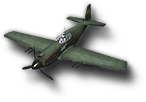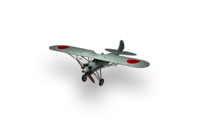Nakajima Type-91
The Nakajima Type-91 is a tier I Japanese fighter. It was built as a prototype to a request from the army, and it first flew in 1931. It became obsolete in 1936 with the coming of the Kawasaki Army Type 95 Fighter. 420 planes were built from 1931-1934.
Type-91
| Prix |
| 60 Capacité de survie |
| 1540 kgPoids |
| 35.7 Dégâts |
| 783.2 Vitesse |
| 260 km/hVitesse max. au ras du sol |
| 260 km/hVitesse max. à altitude idéale |
| 500 mAltitude optimale |
| 440 km/hVitesse en piqué |
| 40.9 m/sTaux de montée |
| 80 km/hVitesse de décrochage |
| 210 km/hVitesse optimale |
| 86.1 Contrôlabilité |
| 8.6 sTemps moyen de rotation 360° |
| 110 °/sTaux de roulis |
| 1482.5 Maniabilité |


Moteur
| Rang | Moteur | Puissance du moteur, ch / Poussée | Type | Poids, kg | Prix, |
|---|---|---|---|---|---|
| I | Jupiter VIIF.P | 520 | refroidi à l'air | 330 | 1550 |
| I | Jupiter VI | 450 | refroidi à l'air | 330 | 0 |
| II | Kotobuki 2 | 580 | refroidi à l'air | 350 | 2200 |

Cellule d'avion
| Rang | Cellule d'avion | Capacité de survie | Poids, kg | Prix, |
|---|---|---|---|---|
| I | NAME_MODULE_NAKAJIMA_TYPE91_SPEC_TOP_TYPE-91_1 | 70 | 1150 | 1200 |
| I | Nakajima Type 91 | 70 | 1150 | 1200 |

Armement extérieur
| Rang | Bombes | Rayon des dégâts, m | Dégâts | Poids, kg | Prix, |
|---|---|---|---|---|---|
| II | WEAPON_NAME_BOMB-30-J_SPEC_TOP_TYPE-91_1 | 35 | 800 | 30 | 200 |

Mitrailleuse synchronisée
| Rang | Mitrailleuse | Calibre | Vitesse initiale, m/s | Dégâts | Cadence de tir, coups/min | Poids, kg | Prix, |
|---|---|---|---|---|---|---|---|
| I | 7.7 mm Vickers-J (S) | 7.7 | 960 | 17 | 600 | 30 | 0 |
| II | 7.7 mm Type 89 (S) | 7.7 | 960 | 19 | 700 | 30 | 1000 |

Compatible Equipment
Compatible Consumables
Avis des joueurs
Points forts/faibles
Points forts :
- Almost all LTH pretty average: speed and agility is slightly worse than the American counterpart, but better weapons.
- The best indicator of the speed of the roll, an order of magnitude better than other start aircraft - 111 degrees per second. The other aircraft in the area of the figure 80.
Points faibles :
- The lowest rate of HP strength. At 50 hitpoints, the Type-91 has the lowest health pool of all planes in WoWp. It is thus highly advised to use your agility and speed to avoid direct fire.
Performance
The Type-91 has good maneuverability, even better than the Soviet I-5, making it the most maneuverable of all tier I planes. It's speed is also very good for tier Is, only coming second after the American P-12
Pretty fast and maneuverable aircraft, with good speed roll that allows you to quickly turn the barrels and other complex shapes. That provides greater potential in a dogfight as dodging enemy fire and attack from the front, followed by entering the tail and counterattack. In many respects, the aircraft still quite low, knocked out, only a small number of strength, only 60 units, so the game on this unit must be careful, as in the following on any Japanese plane. Use maneuvers, do not go to frontal attacks, or in the first row, and then you will succeed.
Informations Historiques
The Army ordered the new aircraft as the Nakajima Army Type 91 Fighter and the first deliveries took place late in 1931. However, issues arose with both directional stability and centre of gravity, with the result that the type was delayed entering service.
Between 1931 and 1934, 420 aircraft were constructed (including 100 by Ishikawajima; 23 of the total were Type 91-2, powered by a 432 kW (580 hp) Nakajima Kotobuki 2 radial engine. This version first flew in July 1934.
The Type 91 was supplanted in service by the Kawasaki Army Type 95 Fighter in 1936-7.
| Fighters | IINakajima A4N • IIKawasaki Ki-10 • IIKawasaki Ki-5 • IINakajima Ki-8 • IIIMitsubishi A5M • IIIMitsubishi Ki-18 • IIINakajima Ki-27 • IIIMitsubishi Ki-33 • IVMitsubishi A6M1 Zero • IVNakajima Ki-43-I Hayabusa • VMitsubishi A6M2 Zero • VMitsubishi A6M3 (experimental) • VNakajima Ki-43-II Hayabusa • VIMitsubishi A6M5 Zero • VIKawasaki Ki-61 Hien • VIKawasaki Ki-88 • VIIMitsubishi A7M Reppu • VIINakajima Ki-84 Hayate • VIIIMitsubishi J8M Shusui • VIIITachikawa Ki-94-II • IXTachikawa Ki-162-I • XTachikawa Ki-162-III |
| Heavy Fighters | VKawasaki Ki-45 Toryu • VIKawasaki Ki-102 • VIIRikugun Ki-93 • VIITachikawa Ki-94-I |
| Attack Aircraft |
